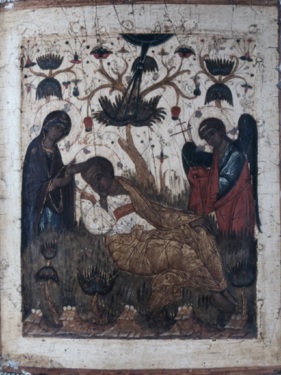
Unknown
Russian
Jesus Christ, The Wakeful Eye, 1550 ca.
egg tempera on wood
12 1/4 × 9 1/2 in.
SBMA, Anonymous Gift
1961.41.2
COMMENTS
Description
Christ Emmanuel (Eternally Youthful Christ) is shown reclining on a grassy hill in an idyllic landscape. He rests His head on His right hand as though Sleeping, but His eyes remain open. He wears a white tunic and a mantle scintillating with golden highlights (chrysography or zolocenie). To the left appears the Virgin Mary, who raises her hands to Christ in supplication. On the right is Archangel Michael dressed in a Prussian blue tunic and a deep red mantle. As a reminder of Christ’s Passion, he carries in covered hands a cross, a spear, and a sponge-topped pole, the instruments used to torture Christ. Behind Christ is a floriated tree in which charming birds perch. At the top, issuing from the arc of the heavens, is a tiny dove enclosed within a medallion, symbolizing the Holy Spirit. As it descends towards Christ the beam of light divides into three parts, an obvious symbol of the Trinity. At the bottom of the scene are five barren hillocks whose symbolic meaning is obscure.
Origin and Iconography
This theme seems to have first appeared in the 15th century along with other narrative subjects derived from liturgical hymns and psalms. The curious reference to “Christ who does not sleep” comes from Psalm 121:4: “The guardian of Israel never slumbers, never sleeps.” It was interpreted to mean that mankind had perpetual access to God by way of Christ Who “never sleeps.”
The Christian Phsiologus explains how the lion sleeps with his eyes open and is constantly watchful of his surroundings. Like the lion, Christ is also awake in order to protect his chosen people. A reminder of Christ’s Passion appears in the instruments of His torture held by the Archangel Michael. The lush garden with the fecund tree symbolizes heavenly Paradise.
Style
Although this theme seems to have first appeared in the Moscow School in the 15th century, the rather broad features of the three figures represented in this example are more typical of the Novgorod School. This artist had a feeling for the decorative: note the Baroque patterns created by the tree’s branches and foliage, as well as the stylized hillocks at the bottom. These decorative features appear to reflect the influence of folk motifs in icon paintings.
- Robert Henning, Jr., "Russian Icons in Santa Barbara," Santa Barbara Museum of Art, 1982
Bibliography
Gerhard, H.P., The world of Icons, New York, 1971, pp. 182, 185-187.
Ikonen-Museum, catalogue, Recklinghausen, 1968, icon No. 73.
Rothemund, Bohs, Handbuch de Ikonenkunst, Munich, 1966, p. 213.
Winkler, M., “Das Nichtschlafende Auge,” Hochand, XLVII (1955) p. 3.
SBMA CURATORIAL LABELS
Medieval popular lore held that lions slept with their eyes open and that their whelps were first born dead, and then brought to life on the third day after birth. In correspondence with such beliefs and with biblical phrases like "He who keeps Israel will neither slumber nor sleep" (Psalm 121:4) and "Judah is a lion's whelp" (Genesis 49:4), this icon shows a youthful Christ lying down with his eyes open. An angel holds a cross, spear and reed: signs of the death and resurrection on the third day. The Virgin Mary stands in prayer, while the Holy Spirit descends from heaven in the shape of a dove: this refers to the Incarnation. The luxurious plants evidently represent the garden of Paradise: Christ is still in the bosom of the Father, before coming to earth as a man. The complex scene was first invented by Greek artists ca. 1300 and subsequently adopted in Russia.
- Religious Images of the Christian East, 2013
